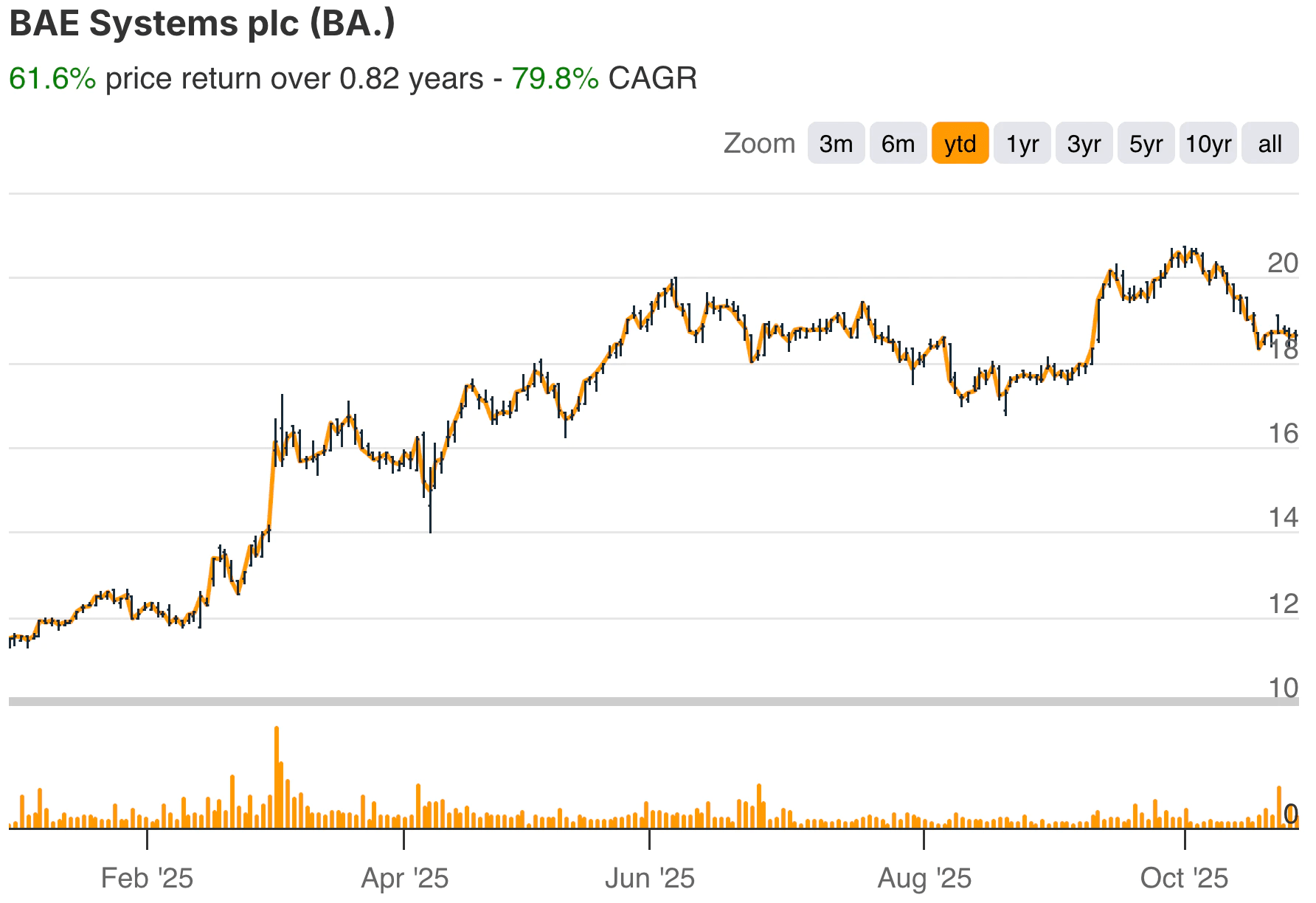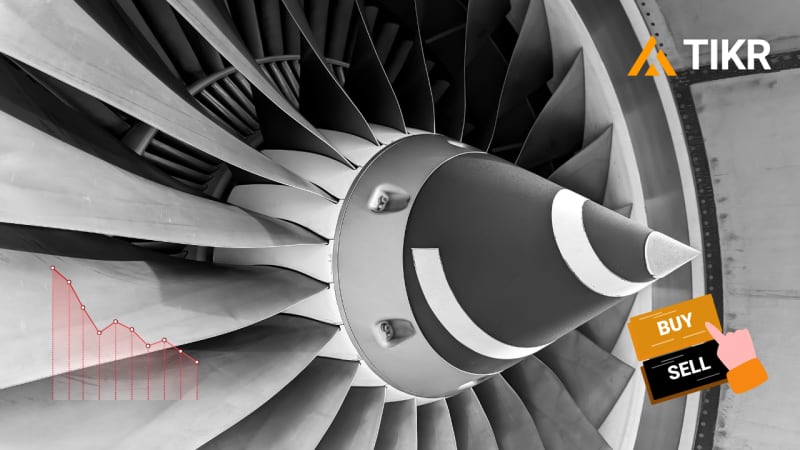BAE Systems plc (BA.) delivered another strong half-year performance in 2025, buoyed by surging global defense spending and long-term program visibility across air, maritime, and electronic systems. The company reported a 10% rise in sales to £13.1 billion for the first half, with underlying EBITA up 11% to £1.4 billion.
Free cash flow reached £830 million, reflecting robust execution and steady demand across key government contracts in the U.K., U.S., and Europe. Management reaffirmed full-year guidance, projecting sales growth between 7% and 9% and margin expansion to 11.7% as program ramp-ups continue in the second half.
Find out what a stock’s really worth in under 60 seconds with TIKR’s new Valuation Model (It’s free)
The company’s order backlog climbed to a record £78.3 billion, up nearly 18% year-over-year, driven by significant new awards, including additional F-35 production contracts, ammunition resupply orders to support Ukraine, and submarine and frigate programs under the AUKUS and Type 26 frameworks.

BAE also continues to strengthen its position in digital intelligence and advanced electronics, which now account for nearly one-third of its pipeline. The group’s diverse geographic footprint, spanning the U.S., U.K., Saudi Arabia, and Australia, provides a stable base of recurring revenue and cash flow, insulating it from regional defense budget cycles.
CEO Charles Woodburn emphasized that both geopolitical tailwinds and a disciplined investment strategy underpin BAE’s long-term growth. The company plans to return more than £1.5 billion to shareholders through dividends and buybacks in 2025, supported by steady margin expansion and operating leverage. With record visibility and a robust balance sheet, BAE enters the next fiscal year as one of Europe’s most reliable defense cash generators, though investors will be watching for signs of supply chain strain and program execution risk as production scales up.
Quickly value any stock with TIKR’s powerful new Valuation Model (It’s free!) >>>
Financial Story
The first half of 2025 reinforced BAE Systems’ position as one of the few global defense firms able to translate order momentum into consistent earnings growth. Group sales rose 10% to £13.1 billion, with underlying EBITA climbing 11% to £1.4 billion. Net operating cash inflow was £1.1 billion, while free cash flow reached £830 million, a sharp improvement from £528 million a year earlier.
Management cited continued efficiency in inventory management and program delivery, particularly within its Air and Maritime divisions. Reported EPS increased 10% to 37.2 pence, and the interim dividend was raised 11% to 13.8 pence per share, marking BAE’s 20th consecutive annual increase.
| Metric | H1 2025 | H1 2024 | YoY Change |
|---|---|---|---|
| Sales | £13.1B | £11.9B | +10% |
| Underlying EBITA | £1.4B | £1.26B | +11% |
| Free Cash Flow | £830M | £528M | +57% |
| Order Backlog | £78.3B | £66.5B | +18% |
| EPS | 37.2p | 33.8p | +10% |
| Operating Margin | 11.5% | 11.1% | +40 bps |
| Interim Dividend | 13.8p | 12.4p | +11% |
Segment performance was broadly positive. The Air division, responsible for nearly 40% of total sales, saw double-digit growth driven by Eurofighter Typhoon support and F-35 production. Maritime posted a 7% gain as Type 26 and Dreadnought submarine programs advanced.
The Electronic Systems segment, which includes next-generation sensors and precision guidance systems, reported an 8% increase in revenues, while Digital Intelligence achieved 6% growth as demand for cybersecurity and AI-enabled analytics continued to accelerate. The company maintained a healthy operating margin of 11.5%, supported by volume leverage and procurement savings across multiple programs.
Look up TranAlta’s full financial results & estimates (It’s free) >>>
1. Defense Spending Boom Fuels Long-Term Growth
Global defense spending reached an all-time high in 2025, surpassing $2.5 trillion, a structural tailwind BAE is positioned to capture. The ongoing conflict in Ukraine, renewed NATO commitments, and modernization programs across the U.S. and Asia-Pacific continue to drive demand for advanced air, land, and naval platforms. BAE’s production ramp-ups in F-35 components, ammunition supply, and shipbuilding are ensuring steady revenue visibility through the decade.
The company’s backlog now spans over a decade of contracted work, underpinned by long-term government partnerships. In addition to the AUKUS submarine framework, BAE secured expanded orders for its 155mm artillery production in the U.K. and U.S., highlighting its role as a critical supplier for NATO allies. This demand momentum supports management’s 2025–2026 outlook for mid-single-digit earnings growth and sustained double-digit returns on capital.
2. Operational Efficiency Offsets Supply Chain Pressure
While defense demand remains strong, execution remains a key variable. BAE’s global supply chain continues to experience tightness in components and skilled labor, though management’s localized manufacturing approach and long-term procurement contracts have mitigated disruption so far. Operating margins expanded modestly in the first half, aided by improved program management discipline and higher throughput in high-margin divisions such as Electronic Systems.
The company’s cash generation continues to impress, supported by rigorous capital control and working capital optimization. Management expects free cash flow of £1.8–£2.0 billion for the full year, reinforcing its capacity to fund buybacks and future M&A. Woodburn reiterated that capital returns will remain “strong and predictable,” with dividends and repurchases tracking profit growth. The emphasis on consistent execution and shareholder discipline has helped keep investor confidence high despite inflation and defense cost pressures.
Value stocks like TransAlta Corporation in less than 60 seconds with TIKR (It’s free) >>>
3. Strategic Expansion and Technology Investment
BAE continues to invest aggressively in emerging technologies, including AI-enabled targeting, electronic warfare, and autonomous systems. The Digital Intelligence unit has become a key growth pillar, expanding revenue 6% in the first half and positioning BAE as a leader in defense cybersecurity and data analytics. The company is also increasing investment in green propulsion systems for future combat air platforms, aligning with sustainability mandates from government clients.
Meanwhile, acquisitions and partnerships are expanding BAE’s reach into new markets. The recently completed minority investment in QinetiQ’s electronic warfare business and new partnerships with Rheinmetall and Leonardo strengthen its European collaboration network. These initiatives are part of BAE’s broader strategy to remain a cornerstone of Western defense infrastructure, technologically advanced, financially resilient, and globally diversified.
The TIKR Takeaway

BAE Systems continues to execute at a high level, turning geopolitical demand into sustainable earnings and cash flow. The combination of a record order book, expanding margins, and disciplined capital allocation makes it one of Europe’s most attractive long-term defense plays. Supply chain pressures and inflation remain watchpoints, but BAE’s visibility through 2030 provides a solid foundation for steady dividend growth and reinvestment.
Should You Buy, Sell, or Hold Bae Systems Stock in 2025?
BAE Systems remains a core holding for investors seeking exposure to the global defense cycle. Its strong backlog, stable free cash flow, and clear visibility into 2026 earnings underpin a durable growth story. With defense spending set to stay elevated and technology investments driving margin expansion, BAE offers a balanced mix of income and capital appreciation potential, a long-term buy for stability in a volatile world.
How Much Upside Does Bae Systems Stock Have From Here?
With TIKR’s new Valuation Model tool, you can estimate a stock’s potential share price in under a minute.
All it takes is three simple inputs:
- Revenue Growth
- Operating Margins
- Exit P/E Multiple
If you’re not sure what to enter, TIKR automatically fills in each input using analysts’ consensus estimates, giving you a quick, reliable starting point.
From there, TIKR calculates the potential share price and total returns under Bull, Base, and Bear scenarios so you can quickly see whether a stock looks undervalued or overvalued.
See a stock’s true value in under 60 seconds (Free with TIKR) >>>
Looking for New Opportunities?
- See what stocks billionaire investors are buying so you can follow the smart money.
- Analyze stocks in as little as 5 minutes with TIKR’s all-in-one, easy-to-use platform.
- The more rocks you overturn… the more opportunities you’ll uncover. Search 100K+ global stocks, global top investor holdings, and more with TIKR.
Disclaimer:
Please note that the articles on TIKR are not intended to serve as investment or financial advice from TIKR or our content team, nor are they recommendations to buy or sell any stocks. We create our content based on TIKR Terminal’s investment data and analysts’ estimates. Our analysis might not include recent company news or important updates. TIKR has no position in any stocks mentioned. Thank you for reading, and happy investing!








